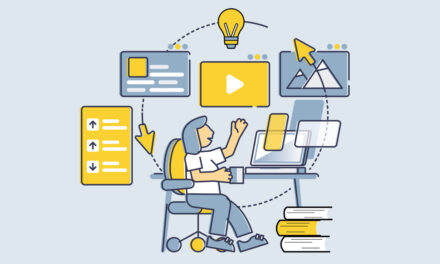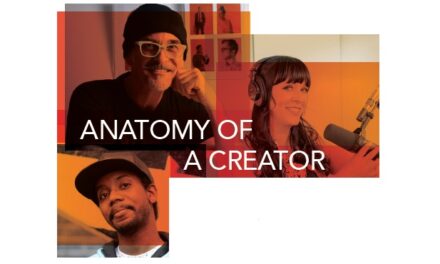In 1807, Charles Wiley opened a print shop, which became the publisher John Wiley & Sons. Now known simply as Wiley, it’s branching out. “We still use the term publisher,” says Brian Morrison, Wiley’s creative director of corporate marketing, “but we’re very much an e-learning company. As that becomes more of our day to day, being able to work with multiple teams, being able to prototype quickly becomes more important. We’re diving quickly into a full-on digital environment. …”
As Wiley moves more toward creating not just print books but dynamic digital experiences, it relies heavily on Adobe XD, a digital design and prototyping tool. “One of the ways that I think XD has been so transformational for us is that we have a lot more people at the table,” Morrison explains, “and XD enables that. It enables great collaboration with folks who are not classically trained designers. In a lot of our meetings, we have a lot of content people involved because it’s very content-specific.”
Morrison continues, “It’s allowing designers to be in the process earlier on, rather than have publishers and marketing folks develop a solution and ship it to design to paint the top layer on it. It’s really focusing on a lot of what I call #creativefromthestart, where it really helps people kind of think about an idea at its inception.”
What is Adobe XD? Cisco Guzman, director of project management for Adobe XD, describes it as an “all-in-one UX [user experience] solution for designing websites, mobile apps,” and almost anything you can think of.
Essentially, for designers and non-designers alike, the idea is to make it easy. Guzman says that Adobe XD “really allows people to do the work together that we know they need to be working on, but not make it painful and harder. The last thing you want is for someone to sort of run from collaborating. We know that getting buy-in and approval and getting things produced is fundamentally about having people work together.”
Morrison explains, “The majority of the projects where we leveraged Adobe XD and are currently live are back-end experiences; there are a few in production from the Wiley Innovation Program. In terms of how I use Adobe XD, I personally use it to quickly prototype ideas with product and marketing teams. It changes the conversation by being able to walk through the experience and make fast changes in real time, rather than collecting bullet points. For many projects, we’ll start in XD instead of Adobe Photoshop. That’s a huge change in the process.”
Morrison goes into more detail about how Wiley uses Adobe XD in its transformation from print book publisher to experience provider: “It’s a tool that everyone can really grasp and understand. Pro users can really go nuts with it, but I could teach someone [so that] after an hour of XD training, they’re able to do it. It’s one of those great common grounds for us to really have collaboration at Wiley.”
Morrison explains that Wiley thinks about the tool in several different ways. “I built a corporate innovation program. It’s a series of workshops that develops new workflows, concepts, and ideas—a lot of new product ideas—in these workshops. Then we assign it to an agile project manager to framework, and then we build these ideas up. And then there’s a different stage of the game where the ideas get invested in, and turned into real-life products.”
Wiley may have started as a local print shop, but now it spans the world. Morrison says, “It’s global. We’re dealing with folks in every region, on calls at 2 o’clock in the morning, 3 o’clock in the morning.” In addition to books, Wiley publishes a variety of e-learning programs, professional certification programs, and scientific journals. “A lot of this stuff is really complicated,” he says. “We’re going through very intricate assessments of people’s personality type, to determine what career path might be best for them. We’re going through trying to figure out a hemoglobin study application. Some of this stuff gets very technical.”
In addition to using Adobe XD to create prototypes, which is an important part of the process, Morrison says he also uses it to share ideas quickly. “We use it as a whiteboard. It’s almost like faster Photoshop, if you will, where we can draw things really quick, in real-time, and get a quick sketch of things. I can then share those sketches very, very quickly. I can invite people to edit those documents, go back to my desk a few hours later and get a ping. Those images are right there, and it’s been updated, and it’s magic. It’s literally what we dreamed about 10 years ago.”
But Morrison says that collaboration and prototyping are “the real fun for us. It’s the collaboration aspect, the pace, the speed. We’re able to build these prototypes so quickly. Integration with our existing stuff enables our pro power users to really take full advantage of it, but I have a lot of folks who’ve never done anything in Photoshop in their life who can go in XD and explain something to me. I can say, ‘I’m not really understanding what you mean by that workflow. Draw some boxes for me.’ And they can do it in XD, where in Photoshop they wouldn’t be able to. It would be a little too much of a hurdle for them. That’s what’s really exciting for us.”
As Wiley builds more dynamic experiences for existing technology, the publishing giant is looking forward to addressing emerging technologies, including voice and mixed reality. As technology moves forward, Wiley is prepared to move with it.






